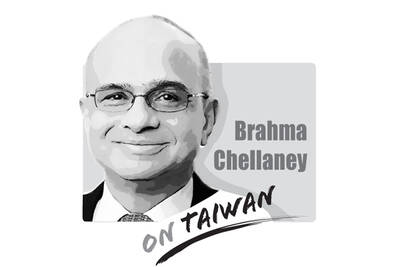President Tsai Ing-wen’s (蔡英文) National Day address yesterday contained no surprises regarding her China policy, as she maintained the stance she set in her May 20 inaugural address that “the pledges we made remain unchanged, our goodwill is unchanged, but we will not succumb to pressure from China, and we will not revert to the old path of conflict and confrontation.”
Beijing was most probably “disappointed,” as it had described Tsai’s inaugural address as an “incomplete test” because it did not recognize the so-called “1992 consensus.” It was probably hoping that Tsai might “complete the test” by providing an “answer” it deemed satisfactory.
Beijing has been pressuring Tsai’s administration into accepting the “1992 consensus” since she took office. Insisting that the “1992 consensus” is the political foundation for cross-strait dialogue and development, China has more than once pointed at the Tsai government’s rejection to recognize the “1992 consensus” as the reason cross-strait communications have been “suspended.”
However, if Beijing has been observing Taiwan as closely as it claims, it should have seen that expecting the Tsai administration to recognize the “1992 consensus” is completely unrealistic.
Taiwan is a robust democracy where the president, who is voted into office, has to respect public opinion.
As Tsai said in a recent interview with the Wall Street Journal, “no administration in Taiwan can make a decision that runs counter to public opinion.”
In an interview with the Japanese Yomiuri Shimbun, Tsai said that “the young people in Taiwan grew up in a free and democratic environment, and have independent thinking and judgement, so they accept values that they can identify with, rather than being indoctrinated” like older generations of Taiwanese.
Whether to accept the “1992 consensus” is a matter that Tsai cannot, and should not, decide alone.
In a poll conducted by the Taiwan Brain Trust in April, 76.2 percent of the respondents said they were unaware of the contents of the “1992 consensus” and only 18.2 percent said they had a clear understanding of its contents. When asked whether they supported letting the “1992 consensus” be the foundation of cross-strait interactions, the poll showed that 52.3 percent of the respondents opposed the idea, compared with 33.3 percent who supported it.
In addition, 62.1 percent said they cannot accept Beijing’s repeated attempts to pressure the Democratic Progressive Party (DPP) government into accepting the “1992 consensus” and make it a prerequisite for cross-strait exchanges.
The poll shows that — despite former president Ma Ying-jeou’s (馬英九) and the Chinese Nationalist Party’s (KMT) clamoring during his eight years in office that the “1992 consensus” refers to a tacit understanding between the KMT and Beijing that both sides acknowledge there is “one China,” with each side having its own interpretation of what “China” means — most Taiwanese do not know what it is, nor do they accept it.
Chinese officials have said that they hope for peaceful cross-strait development. If they truly mean it, then they should engage in dialogue with the DPP government and forge a new understanding for cross-strait relations, rather than holding on to a fictional “consensus” that is neither supported nor recognized by Taiwanese and their government.

As strategic tensions escalate across the vast Indo-Pacific region, Taiwan has emerged as more than a potential flashpoint. It is the fulcrum upon which the credibility of the evolving American-led strategy of integrated deterrence now rests. How the US and regional powers like Japan respond to Taiwan’s defense, and how credible the deterrent against Chinese aggression proves to be, will profoundly shape the Indo-Pacific security architecture for years to come. A successful defense of Taiwan through strengthened deterrence in the Indo-Pacific would enhance the credibility of the US-led alliance system and underpin America’s global preeminence, while a failure of integrated deterrence would
The Executive Yuan recently revised a page of its Web site on ethnic groups in Taiwan, replacing the term “Han” (漢族) with “the rest of the population.” The page, which was updated on March 24, describes the composition of Taiwan’s registered households as indigenous (2.5 percent), foreign origin (1.2 percent) and the rest of the population (96.2 percent). The change was picked up by a social media user and amplified by local media, sparking heated discussion over the weekend. The pan-blue and pro-China camp called it a politically motivated desinicization attempt to obscure the Han Chinese ethnicity of most Taiwanese.
On Wednesday last week, the Rossiyskaya Gazeta published an article by Chinese President Xi Jinping (習近平) asserting the People’s Republic of China’s (PRC) territorial claim over Taiwan effective 1945, predicated upon instruments such as the 1943 Cairo Declaration and the 1945 Potsdam Proclamation. The article further contended that this de jure and de facto status was subsequently reaffirmed by UN General Assembly Resolution 2758 of 1971. The Ministry of Foreign Affairs promptly issued a statement categorically repudiating these assertions. In addition to the reasons put forward by the ministry, I believe that China’s assertions are open to questions in international
The Legislative Yuan passed an amendment on Friday last week to add four national holidays and make Workers’ Day a national holiday for all sectors — a move referred to as “four plus one.” The Chinese Nationalist Party (KMT) and the Taiwan People’s Party (TPP), who used their combined legislative majority to push the bill through its third reading, claim the holidays were chosen based on their inherent significance and social relevance. However, in passing the amendment, they have stuck to the traditional mindset of taking a holiday just for the sake of it, failing to make good use of